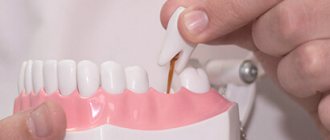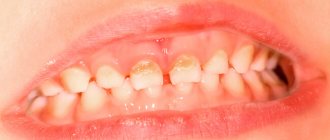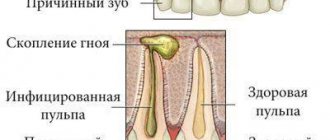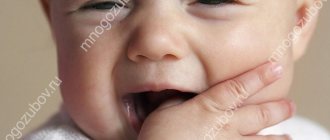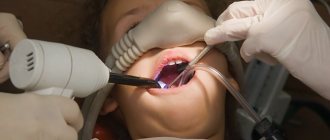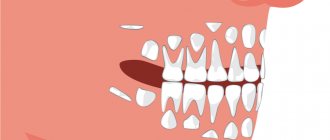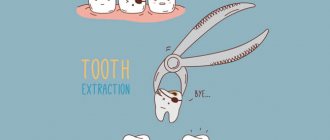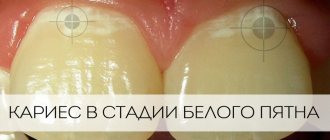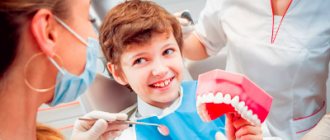How to pull out a baby tooth with floss
The essence of the method is that a loose tooth is tied with a thread, the other end of which is tied to the door handle.
The door opens and the tooth flies out of the mouth. This technique does not withstand any criticism either from dentists or from psychologists. A morally outdated method that can frighten a child and even cause psychological trauma.
Home manipulations often lead to infection in the socket. Inflammation may develop - flux, pain and fever will appear. The best solution is to have loose baby teeth removed at a dental clinic. It's fast, painless and inexpensive.
A baby tooth falls out, why and how it happens
Changing a child's baby (temporary) teeth to permanent ones is a natural process. It occurs as the jaw bones grow and develop. The task of parents, when baby teeth fall out, is to treat this with increased attention. There are often cases of malocclusion in children, which subsequently have to be corrected for a long time and then treated. One of the main reasons for this is a violation of the sequence of loss of primary teeth.
What to do if blood appears during tooth loss?
Some parents immediately panic when their baby starts bleeding during the loss of a baby tooth, but this should not be done. This process is considered absolutely normal; it occurs due to the fact that there are a large number of blood vessels in the oral cavity. When a tooth falls out, these vessels burst, and therefore a bleeding process occurs. To stop the bleeding, the following measures should be taken:
- If blood appears, the child should be given a cotton swab or piece of gauze. He must press it to the hole with blood and hold it for a while. Usually the bleeding stops quickly;
- It is not recommended to use hydrogen peroxide to rinse the mouth, because it will only irritate the wound, but will not bring a positive result;
- If the bleeding does not stop and simple manipulations do not help stop it, then you should go to see a dentist;
- In the first period after tooth loss, the child should rinse the mouth with a solution with a weak salt concentration.
Sometimes there are situations when a tooth falls out unnoticed even by the child himself, and he may accidentally swallow it. In these cases, it is worth contacting a dental specialist who will examine the hole and be able to determine whether the tooth has completely fallen out or whether part of it has broken off. If it turns out that the tooth has fallen out and the child has no complaints, then soon enough it will leave the body naturally.
Rinsing with a weak saline solution will disinfect the oral cavity and inflammation after the loss of a baby tooth.
Process Features
The chewing apparatus in children, in the first years, actively develops and improves. It is explained by the following factors - in the first months of life, it is adapted only to receive breast milk, and then other liquid and porridge-like foods. The eruption of the first milk teeth usually begins at 5-6 months. Around this time, solid foods are gradually introduced into the child's diet.
Parents should know how many baby teeth fall out in children, at what age and what causes this. This process is associated with freeing up space for permanent teeth as the dentofacial apparatus forms. In newborns, the jaw size is quite small, so only 20 milk teeth are placed here - 10 on top and 10 on the bottom. When the size of the jaw bones increases, they are naturally replaced by permanent ones, the number of which is greater (32) and they are larger.
How to save your front baby teeth
The main and main cause of damage to the upper anterior incisors in children at an early age is “bottle caries”. And today it is far from uncommon. Moreover, caries begins at a very early age (sometimes even in infancy) and develops not just quickly, but rapidly. Where does it come from? It's simple: caries develops as a result of night feeding with breast milk, artificial formula, compote or juice. Any sugar-containing liquids literally stick to the teeth, flowing from the side on which the baby sleeps and to the front upper teeth. And since saliva is not produced during sleep, sugar remains on the teeth and begins to destroy the enamel, which leads to caries. To the greatest extent (90% of cases) it affects the upper incisors and chewing teeth. And if the treatment of the latter does not cause any particular difficulties, then there are still many questions, disputes and disagreements regarding the front incisors.
Where does caries begin?
Caries begins with a white spot on the tooth, which most often goes unnoticed if the baby is not shown to the pediatric dentist in time. The “white spots” do not bother the baby himself. However, literally within a few months, carious cavities can become very deep, causing the child quite severe discomfort during meals and even at night.
What happens if you don’t treat your child’s teeth?
It’s simple, a fairly extensive chronic inflammatory process will arise, the frequent companions of which, in addition to dental problems themselves, are loose tonsils and other ENT diseases and even diseases of the gastrointestinal tract. In addition, bone tissue and the rudiments of permanent teeth suffer from chronic infection. And when the process reaches a “critical point,” the matter can end in fluxes and purulent fistulas, which are often accompanied by acute pain and high fever.
"Important" age
Children aged 1.5 to 4 years usually turn to pediatric dentists with similar problems. And often children come with almost destroyed front teeth. Namely, during this period, the front incisors are more important than ever, both from an aesthetic and functional point of view: they bear a fairly high load associated with biting food, especially hard food. In addition, without the front teeth, the bite (subsequently there may not be enough space in the jaw for permanent teeth) and speech (the tongue does not have support, and the child begins to lisp) are formed incorrectly. And of course, like adults, kids worry about the beauty of their smile. If black, dilapidated “stumps” stick out in the mouth instead of beautiful white teeth, children are embarrassed to smile and constantly cover their mouths with their hands.
And by the age of 5, the resorption of the roots of milk teeth will begin, and by 6-7 years, permanent teeth should erupt, the health of which directly depends on the condition of their milk predecessors. That is why you need to take care of the health of your upper incisors as early as possible.
What's the difficulty?
There are several reasons why treating frontal teeth in children is very difficult.
Firstly, only when treating incisors with deep damage to the enamel is the passage of canals mandatory. That is, everything is the same as in adults: you need to drill out the tooth, remove the nerve, take before and after pictures, go through the canal with a special material, and only after that can you put a filling. Therefore, treatment of only one front incisor takes 30-40 minutes!
Secondly, as we said, the main patients with caries of the front teeth are children from 1.5 to 3-4 years old (in 80% of cases these are children aged 2-3 years), so treatment is possible only under general anesthesia. For such a baby, finding contact “with someone else’s aunt” is still, to put it mildly, difficult, and the perseverance is still not enough to withstand such a long time in the dentist’s chair (if only the doctor needs an average of 30-40 minutes for one tooth, and such teeth 4 – so count for yourself).
By the way! It does not happen that one or two teeth are affected by caries, and the rest remain healthy - usually all 4 front incisors are always affected.
Background
It is because of all these difficulties that until recently there were not so many ways to “treat” the upper anterior incisors.
Depending on the degree of damage, the teeth were covered with silver. But since this approach gives absolutely no effect, the carious process soon destroyed them completely, and then the teeth had to be removed. The “side effects” of this method also include the fact that the “silver” makes the teeth turn black and, to put it mildly, does not look aesthetically pleasing, which only adds to the problems.
If the situation allowed, then sometimes it was possible to fill the canals in order to save space in the upper jaw for permanent teeth, and in the place of the former “milk jugs” there remained small “stumps” that were in no way capable of fulfilling their functional tasks, not to mention their appearance.
Another “popular” approach is to leave everything as is for as long as possible. We have already talked about fluxes and temperature. Actually, they became the consequences of such “treatment”. Result? Parents are simply forced to bring their child to the clinic for removal.
By the way! In the absence of teeth, the jaw narrows, and this subsequently negatively affects the bite: there is not enough space for permanent teeth!
True, sometimes with the help of all kinds of rinses and “traditional methods of treatment” at home, this acute process is removed, the baby rinses out the pus and continues to live with bad teeth and a chronic infection in the mouth, from which the bone tissue suffers.
By the way! Until 3 years of age, mineralization of the rudiments of the anterior permanent teeth occurs. And in fact, they are formed under conditions of constant inflammation and chronic infection. This means that the rudiments of permanent teeth do not develop normally: the teeth will be weak, and the enamel will be of uneven color and in some places immature.
What to do if teeth are removed after all
One of the modern solutions to this problem is a replacement plastic plate. However, although it holds the jaw well for permanent teeth, it is otherwise purely aesthetic in nature (outwardly it looks like real teeth), without bearing any chewing load.
The plate can only be installed at the age of 4.5-5 years. The fact is that it requires a conscious attitude on the part of the child. You need to take care of the plate, clean it, remember to take it off and put it on, you need to get used to it, like any other foreign object in the mouth. That is, the baby must understand why he is doing it, and, what is important, want to do it! And it is not always possible to “agree” with a child; it is especially problematic to do this with boys.
In addition, if teeth were removed at 2 years old, then at least until the age of 4 years the baby is forced to live without teeth, which is not physiological. Restoration of anterior teeth as an art of pediatric dentistry
Over the past few years, a number of clinics have begun to restore the anterior incisors. The roots of these teeth are treated, pins are placed, and the crown of the teeth is restored using filling materials. For aesthetic restoration, materials of different colors with corresponding names are used - “dentin”, “enamel”, “incisal edge”, so that the teeth can look as close as possible to their real teeth. Crowns: a modern and effective solution
Fortunately, today there is a solution to the problem of the upper incisors, such as crowns. Crowns are made of a hypoallergenic alloy and lined with zirconium oxide. This is a rigid and durable structure, which, like in adults, is attached to cement and holds the tooth well. In addition, from an aesthetic point of view, crowns look good. And children truly appreciate this: they begin to smile with pleasure without covering their mouth with their hand.
So, how does a crown “work” and help save teeth? The root of a tooth affected by caries is treated, the nerve is removed, and a canal is traversed. If the tooth tissue is preserved, then it is minimally filled; if not, then a pin is installed, and the tooth itself is restored (restored) with filling material. On top, slightly under the gum, crowns are placed, which play the role of protective “caps,” mechanically holding the tooth and helping to preserve the restoration until the teeth are replaced with permanent ones. It is by installing it under the gum that the crown helps protect the restored tooth, which consists of 90% filling material, when bitten off or injured.
Since by the time of treatment there is nothing left of your own tooth, crowns are selected “by eye”: impressions, like for adults, are never made. Based on the size of the roots and adjacent teeth, as well as the structure of the jaw, we can determine what size crowns are needed. However, we always install crowns that are slightly smaller than our real teeth to avoid the teeth not coming together when the child wakes up from anesthesia. Over the next few months, the installed crowns “sit” in the bite due to the plastic childhood periodontium and a number of other physiological features. If, for example, when fixing the crown, the crown was turned out, then when the baby comes for a consultation after 2-3 months, the teeth are in a row. Nature literally helps children. This simply cannot happen to an adult!
By the time the baby teeth are replaced by permanent ones, the roots of the “milk jugs” begin to dissolve. As a result, the crowns fall out along with the pin, and permanent teeth take their place.
Clear benefits
Of course, both of these methods allow you to preserve the front incisors until they are physiologically replaced. It is very important! But let's figure out how the baby feels...
Firstly, after treatment of the roots of the teeth and subsequent restoration, the child begins to eat normally and gains weight: after all, with severely damaged teeth, as we said, contact with food causes discomfort and sometimes even acute pain. Meat, apples, carrots appear in the toddler’s diet - that is, things that he simply could not bite or chew before. Secondly, since nothing bothers the baby (and at the stages of deep caries, children often experience pain at night), he sleeps better. Thirdly, the teeth look very aesthetically pleasing, and now the baby can smile from ear to ear without embarrassment. Tell me, is this not enough?
It's important to remember that...
...installing crowns takes less time than aesthetic restoration of teeth using filling materials. And this, in turn, allows you to reduce the time of anesthesia. In addition, the filling material gains color over time (stained by food and drinks), cracks appear on it, so it must be polished periodically. And lastly: crowns allow for 70% better preservation of teeth, protecting them from injury and mechanical damage during chewing. But the materials used for restoration are not strong enough and often break.
Nevertheless, the method of preserving the front teeth in each case is selected individually, depending on a number of indications and contraindications, the state of the oral cavity, etc. The main thing is that now it has become possible! We are convinced that if it is possible to save a child’s teeth for 2-3 years, ensuring normal chewing and jaw development, then this is a huge achievement and truly “aerobatics” for pediatric dentists.
When do teeth start to fall out and until what age?
With normal child development, this process begins at 5-7 years, but there may be deviations. Explained by the following factors:
- Heredity;
- Features of development;
- Gender of the child (girls earlier);
- Past illnesses;
- Presence of pathologies;
- Vitamin D deficiency;
- Injuries.
When a child’s baby tooth falls out, you shouldn’t be scared; you need to be prepared, as children often begin to complain of pain when biting into solid food. It is necessary to control the formation of the correct bite, for example, if the loss occurs much earlier or, on the contrary, with a great delay, then it is better to consult a dentist for advice
Waiting for the tooth fairy
The most popular tradition in the modern world is the tale of the tooth fairy. This tradition began in Iceland, but gradually it spread to America, and then it was adopted by almost the whole world. This transition occurred thanks to the cartoons that children watch.
According to tradition, when a baby loses a baby tooth, he should put it under the pillow, and when the child falls asleep, a little fairy with wings flies to him. With a wave of her magic wand, she takes out a tooth from under the pillow, and in its place puts a coin or sweets. This is the fairy tale that modern children believe.
If a tooth was removed at a dental clinic, then parents can confidently ask the dentist to give the tooth back so as not to upset the child, and also put it under the pillow at night.
Parents who do not believe in omens requiring burning, burying or any other actions with baby teeth can, after “magically” replacing the tooth with sweets or money, wrap the tooth in a napkin and dispose of it in the usual way. Whatever decision is made, it is important to preserve the child’s faith in magic and the importance of the events taking place.
Sequence and estimated dates
Parents should know which baby teeth fall out first in children, as well as the sequence. Doctors adhere to the following scheme:
- Central incisors - 5-7 years;
- Lateral incisors - 7-8 years;
- Molars (1st upper jaw, 2nd lower jaw) - 9-11 years;
- Fangs - 9-12 years;
- Molars (2nd upper jaw, 1st lower jaw) - 10-13 years.
It is important to take into account that here is a generally accepted scheme and approximate dates when baby teeth fall out and permanent ones begin to appear, but depending on many factors there may be some changes that can be considered normal. However, if significant deviations are noticed, you should not delay your visit to the doctor.
The order of changing baby teeth in children by age
After the age of 3 years, parents can take a little break from the changes. And then, at about 5 years of age, the baby teeth are replaced by permanent teeth. The process begins with the lower incisors. Then, after about a year, chewing “sixes” are cut, which parents may mistakenly mistake for milk ones. After another year, the upper incisors are replaced.
To go through this journey with your child without problems and pain, visit the dentist regularly. Children may experience pain simply from jaw expansion. Your doctor can easily tell you the cause of the discomfort. The age of 6–7 years shows the prospect of bite formation. Here you can quickly correct problems that arise so that by adolescence your child has a smooth, beautiful smile.
Next, the procedure for replacing baby teeth continues with the upper lateral incisors by the age of 8 years. At the age of 9–10 years, the molar first premolars appear, followed by the second premolars a year later. 12–13 years is the age when canines appear, and at 14 years the last second molars are cut.
The procedure for replacing baby teeth ends with the complete formation of a bite of 24 teeth.
What complications can there be?
A timely visit to a pediatric dentist will help prevent serious problems in the future. With the development of modern technology, this is not difficult to do. For example, if a baby tooth falls out too early, a special system can be installed that will provide enough free space for a permanent one. The design is absolutely painless and does not interfere with the child’s eating, talking and oral care.
Another problem that often occurs in medical practice is the failure of permanent teeth to appear in empty spaces for a long time. The main reasons are:
- Adentia - absence of a root;
- Retention - retention of a tooth in the alveolar process or jaw (can be complete or partial);
- Impaction - there is not enough space in the dentition, and the crowns prevent each other from growing.
Therefore, it is important to know how long it takes for children to lose their baby teeth and to carefully monitor the process, from beginning to completion. If there are significant deviations from the norm, it is better to visit an orthodontist.
What to do if the tooth, on the contrary, does not loosen
If a molar is already visible above the baby tooth, which is about to erupt, then this is a reason to visit an orthodontist. If such a baby tooth is not removed in a timely manner, then an expensive bite correction will be required to force the permanent tooth to fall into its proper place.
In this case, an orthopantomogram will also help, which will allow you to see where the molars are located.
Anatomical differences between primary and permanent teeth
As we said above, temporary teeth differ from permanent teeth in a smaller number, as well as in significantly smaller sizes (they are 2 times smaller than permanent teeth).
At the same time, the shape of the crowns of primary teeth is always more spherical, and in the area of the neck of the primary tooth there will always be a noticeably more pronounced narrowing. In addition, temporary teeth are whiter than permanent teeth and often have a bluish tint. Differences between temporary and permanent teeth (description below) –
Anatomical differences:
- Tooth enamel – the enamel of temporary teeth is much less mineralized (saturated with minerals, primarily calcium and phosphates). Therefore, with insufficient oral hygiene, children develop caries almost instantly. In addition, the thickness of the enamel of temporary teeth is approximately 2 times less than that of permanent teeth - this circumstance leads to a very rapid transition of caries to pulpitis. There are also many microcracks and pores on the surface of the enamel of temporary teeth.
- Dentin of the tooth - the dentin layer is located under the layer of tooth enamel, and its thickness is also 2 times less (than that of permanent teeth). The dentin of temporary teeth is lighter, it is less mineralized, softer, and therefore it is much easier to prepare with a drill than the dentin of permanent teeth. Due to the fact that dentin is less mineralized and softer, the carious process in dentin spreads deeper faster, which leads to the rapid development of pulpitis in baby teeth.
- Pulp (neurovascular bundle) - some parents ask: “Are there nerves in baby teeth?” Of course, they exist, but due to the thinner layers of enamel and dentin, the pulp in baby teeth is located much closer to the surface of the tooth. The pulp chamber (tooth cavity), in which the pulp is located, is always larger in primary teeth, and therefore the pulp occupies a relatively large volume in the tooth. And besides, in baby teeth the “pulp horns” (processes) are more pronounced, which creates an additional danger of injury to the pulp during the treatment of caries.
- Roots of teeth – some parents ask: “Do baby teeth have roots?” Of course, they have roots, but they are thinner and widely spaced (at the same time, the root canals and apical openings in baby teeth are wider than in permanent teeth). But the development and growth of the rudiments of permanent teeth leads to the formation of constant pressure on the roots of primary teeth, which leads to their gradual resorption and loss. We hope that our article: Scheme of loss of baby teeth in children was useful to you!
Sources:
1. Dental education of the author of the article, 2. Based on personal experience as a dentist, 3. The European Academy of Paediatric Dentistry (EU), 4. National Library of Medicine (USA), 5. “Pediatric therapeutic dentistry. National leadership" (Leontyev).
Why is the order of changing teeth important?
First, the incisors, and only then the molars and canines - this order determines the normal course of jaw development and the formation of a correct bite. If teeth fall out in the wrong order, this can lead to malocclusion and subsequent problems.
Malocclusion is not only an aesthetic problem that changes facial features, but a physiological one. As a result, pronunciation and clarity of speech are impaired, the quality of chewing food deteriorates, which can lead to disruptions in the functioning of the gastrointestinal tract.
Several reasons can cause a disorder in the order of tooth loss:
- trauma - the baby hit himself and knocked out or damaged a tooth, causing it to fall out prematurely;
- diseases of the oral cavity - enamel hypoplasia, caries or pulpitis.
It happens that parents “neglect” the condition of the child’s oral cavity, believing that there is no need to care for or treat baby teeth. They'll fall out soon anyway. This leads to negative consequences.
Firstly, the baby does not develop a culture of oral care. And at an older age, he will not closely monitor the health of his molars, which will cause the active development of carious processes and their early loss.
Secondly, caries of baby teeth is not a harmless disease. It destroys teeth, causing them to fall out earlier, spreads aggressively in the mouth and can infect the molars and molars, which are located in the gums. Caries in children must be treated. And the sooner parents notice white or dark spots on the enamel and the sooner they consult a doctor, the greater the chance that the doctor will “catch” the disease at an early stage. And it will not have time to lead to dangerous consequences for the baby’s health.
If the order of changing teeth is disrupted as a result of injury or illness, you should consult a doctor. It is important to consult a pediatric dentist to help get rid of oral diseases. And also an orthodontist, who will recommend options for correcting the primary bite and select means that do not allow the teeth located next to the freed space to move arbitrarily.
pixabay.com/
Why do children lose teeth?
The formation of baby teeth in the jaw begins long before the baby is born. And the eruption of the first tooth becomes a real event. This usually happens at six months: parents notice bumps on the lower gum, the baby becomes capricious and restless. And after some time, the mouth is decorated with white “caps” of the first central incisors.
A little later, after two to four months, they are paired with the central incisors on the upper jaw. Then the lateral incisors, canines and molars appear in the mouth. The latter grow up by about two and a half to three years, and by this age most children acquire a complete milk bite. 20 baby teeth will serve the baby for at least another two to three years.
As the baby grows, his jaw also changes. It becomes larger, and if up to three years the teeth were arranged in dense, neat rows, then later gaps will begin to appear between them. Parents should not worry - this is a natural and necessary process. Interdental spaces, called diastemas, are needed so that later molars, larger than baby teeth, can take their place.
At the age of six or seven years, the changes become even more noticeable. The baby's first tooth may fall out. Usually, the one that appeared first, that is, the central incisor of the lower jaw, falls out first. This event indicates that the milk bite will begin to change into a permanent one. The baby’s body will need time to completely renew its dentition. This takes on average four to five years, and there is no need to rush things.
pixabay.com/
Parents are often worried that their children’s teeth are already actively changing, but their baby still walks around with a full, milky smile. These experiences are usually in vain, since nature has not programmed the only correct time for a person to change their bite. The indicated age for the loss of the first tooth is conditional. For some children this happens earlier - for example, at five years old. For others - after seven years, when the baby goes to school. It has been noticed that girls acquire molars earlier than boys. At the same time, the age at which baby teeth fall out is not as important as the correct order.
Delete correctly
If the situation is not critical and there are no painful symptoms, you can do without consulting a doctor. But there is no need to rush into removal; it is better to help the tooth fall out on its own. There are some tips to speed up the process:
- Loosening a tooth with a tongue or finger: Invite your child to gently wiggle a loose tooth in different directions with his tongue. A curious baby will most likely touch the tooth with his fingers, so talk to him in advance about the need to wash his hands thoroughly. Remind your child that there is no need to use much force, just to gently loosen the tooth.
- Brushing your teeth with special enthusiasm: you can apply force to the crown of a baby tooth, brushing it more thoroughly and for longer. You should try to press the brush on the root part.
- Eating solid foods: Offer your child apples, carrots or crackers. Very often, children get rid of their baby teeth during meals, and this is completely painless.
If a tooth is loosened but does not fall out despite the impact, you can resort to self-removal. The child’s positive attitude is very important - tell him about what you will do, you can come up with a fairy tale together about a boy or girl who was in vain afraid to pull out a tooth, or discuss gifts from the tooth fairy.
To remove, you will need nylon or dental floss and a glass of antiseptic solution. It is better to remove a tooth in a well-lit room. Before the procedure, encourage your child to brush their teeth and rinse their mouth with the solution. You can pull out a tooth using a thread: tie it around the crown part and sharply pull it upward if the tooth is lower, and vice versa downward if the tooth is upper.
Removal by hand is permissible using a sterile bandage: wrap it around your fingers, grab the tooth around it and carefully twist it in different directions. Pull down or up in the opposite direction. Cover the wound with sterile cotton wool.
Is it normal for a baby tooth to have not fallen out yet, but the molar tooth is already growing?
It also happens that a child’s teeth begin to grow “in two rows.” Many parents find this funny and are in no hurry to take their baby to the doctor, waiting until the baby tooth falls out on its own. And this is an erroneous position, which will only add to bite problems in the future.
As a rule, the molar, which grows under a tightly seated deciduous tooth, finds its exit in the gum from the side of the tongue. Incorrect position disrupts the bite. And the longer competitors fight for one place, the more crooked the permanent tooth will grow.
“Such cases are due to the anatomical features of the child’s oral cavity,” notes Victoria Arutyunova. — The permanent tooth is already growing, but the root of the milk tooth has not yet resolved. In this situation, you need to help the child get rid of the tooth, since, as practice shows, it cannot fall out on its own.”
